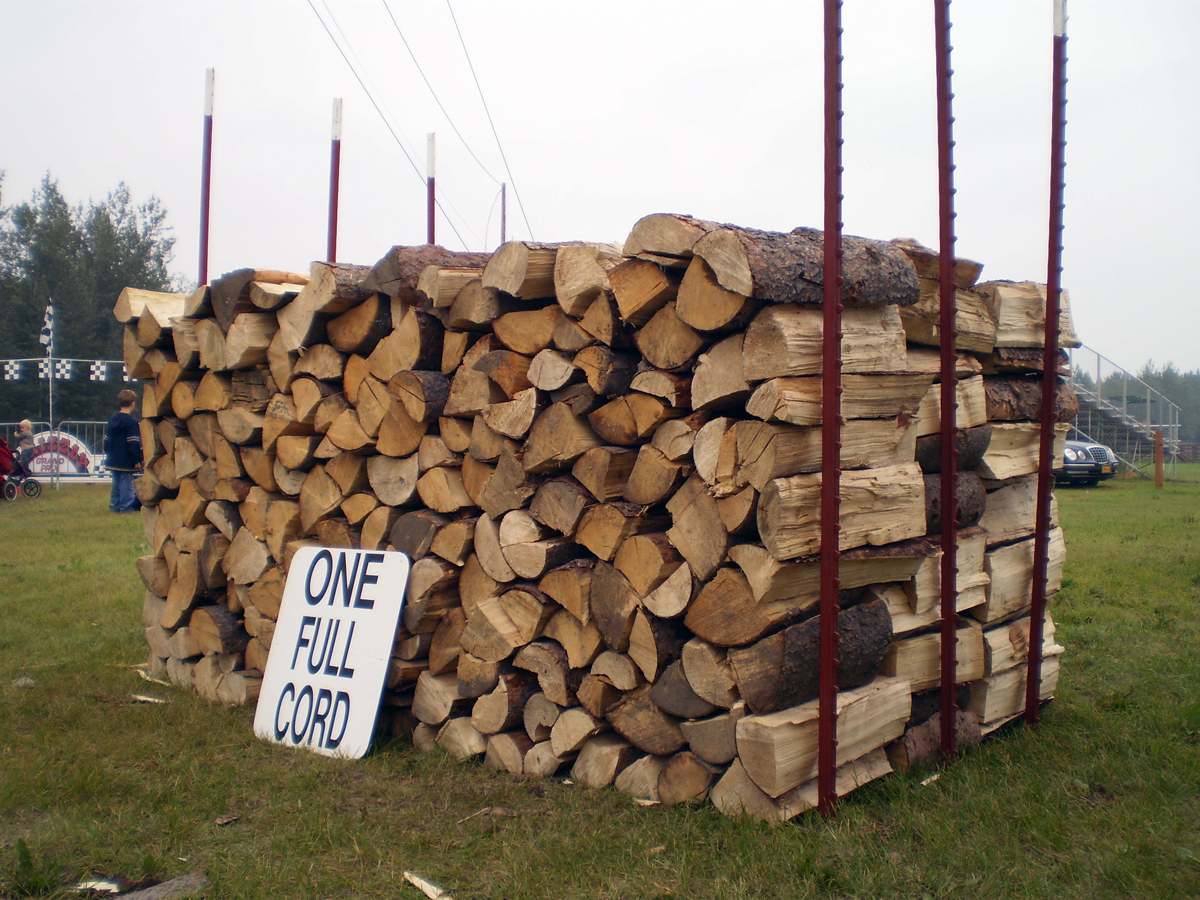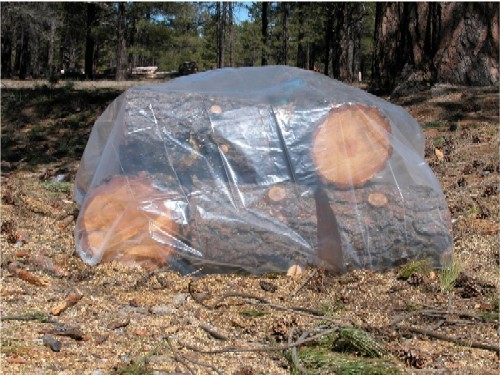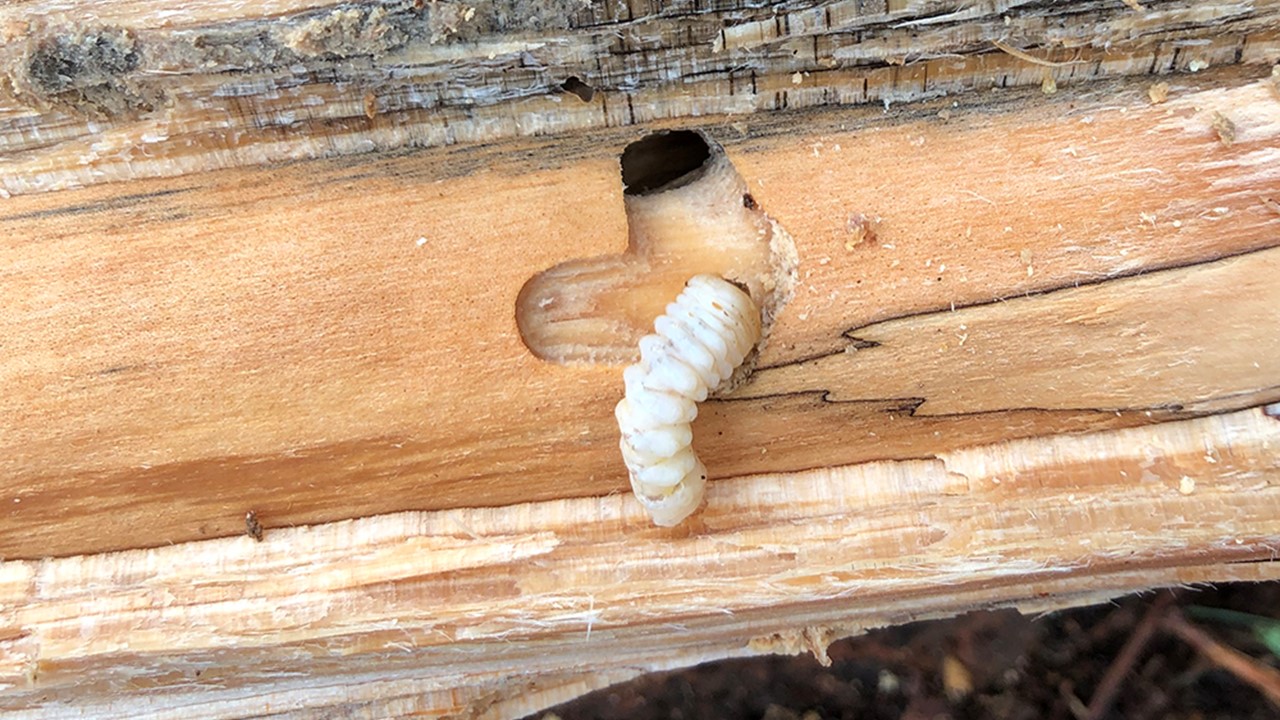Firewood: Recommendations for using Firewood as an Indoor Heating Source in Oklahoma
- Jump To:
- Introduction
- Benefits of Using Firewood for Heating
- Finding and Processing Firewood
- Determining the Amount of Firewood You Need
- Drying Firewood
- Creosote Best Management Practices
- Protection from Insects and Diseases
- What Kind of Wood Should You Use for Firewood?
- For more information, refer to the following OSU Extension publications:
- References
- Resources
Introduction
Oklahoma’s diversity of landscapes provides growing conditions for a wide variety of plants, ranging from pinyon pine in the panhandle to baldcypress in the southeastern corner of the state. Trees are grown for a variety of purposes, including wind breaks, shade, wildlife habitat or conventional wood products. While forest products are conventionally thought of in terms of “boards and cords” of lumber and paper pulp, alternative products may include biofuels, playground mulch, fruits and nuts, and firewood.
Average January minimum temperatures range from 18 degrees Fahrenheit in the panhandle to 32 degrees Fahrenheit in the southeastern corner of the state (Brock et al. 1995, McPherson et al. 2007). Below-zero minimum temperatures are infrequently recorded, although they are not uncommon, especially in the panhandle. Minimum heating recommendations include maintaining an indoor temperature of 65 degrees Fahrenheit (Jevons et al. 2016). Fifty-one percent of Oklahoma’s heating is powered by natural gas and 40% by electricity (US Census Bureau, 2021). In rural areas not serviced by natural gas lines, LP gas or wood are primarily used. Firewood is the primary heat source for 2% of Oklahoma homes, although a substantial number of homes use wood as a secondary heating source, and firewood is used for outdoor heating purposes and as “hog fuel” in biomass operations.
Benefits of Using Firewood for Heating
There are many benefits to using firewood for heating. Whereas prices of oil, natural gas and other petroleum products can be volatile, the price of firewood is comparatively cheap and stable. Firewood is also derived from a renewable resource, while any petroleum product is not. After the initial cost of stove installation, the cost to heat using firewood is quite cheap. Firewood as a fuel source also allows homeowners to use an entirely local product for heating.
Finding and Processing Firewood
There are many options to obtain fuel for wood heating. If there are trees on your property, you may cut your own with a chainsaw, axe and wood splitter to make wood pieces sufficiently small. If you do not own trees, you can buy irewood and pick it up or you can have firewood delivered to your property. If you cut your own firewood, there are several considerations. For chainsaw safety, refer to SUNUP TV’s chainsaw safety video. You can also find more chainsaw safety operation information from the Forestry Industry Safety and Training Alliance and from chainsaw manufacturers. If you cut your own firewood, try to cut firewood pieces no larger than 5” diameter by 16” long. This starts by felling and limbing your tree, then bucking the tree into shorter, manageable lengths and eventually 12-16” lengths that can be split into narrower diameters either with an axe or a log splitter.
Figure 1. Full Cord of Wood.1
Determining the Amount of Firewood You Need
Determine the amount of firewood you will need for your cold weather heating. One or two cords per 1,000 square feet may be all you need. For reference, one cord of firewood is a 128-cubic foot stack of firewood or a stack that is 4 feet tall by 4 feet deep by 8 feet long. This includes the bark and airspace between pieces, but it generally assumes the firewood is stacked into as small a space as possible. It can get complicated when the firewood is thrown into the back of a truck and not stacked. Even when stacked well, one full cord will not fit into a ½ ton pickup truck bed. You may hear other terms as well. A face cord, or rick, is roughly 1/3 of a full cord or a stack that is 4 feet tall by 16 inches deep by 8 feet long. A half-face is half of a face cord. Make sure that when you are conversing with your firewood provider, you are both referring to a standard cord, which is 128 cubic feet.
Drying Firewood
Firewood that is ready to burn should be sufficiently dry. Firewood that has high moisture content requires more energy to boil excess water, which results in less heat production. Considering wood smoke consists primarily of water vapor, low firewood moisture content reduces the amount of smoke produced when burning. Low moisture content also decreases the amount of creosote production on your chimney and reduces harmful chemicals and particulate inhalation. For more fireplace and wood safety information, refer to:
Plan ahead, and cut your firewood at least 6-9 months before you plan to use it, so it is properly seasoned. The goal of seasoning is to lower the wood moisture content by not exposing the wood to moisture and by providing plenty of ventilation. Properly seasoned, ready to burn firewood should ideally be no more than 10-20% moisture content.
There are several passive options to dry your firewood, including air drying by stacking firewood in a way that allows air circulation over as much wood space as possible. To kill any insect or disease pests in your firewood, you can use plastic sheeting in a process called solarization. This process essentially involves tightly covering the top, sides and underside of your firewood stack in thick, clear plastic sheeting. The firewood stack must be outdoors, in a place that receives full sun during daylight hours. Three to six months should be sufficient time for solarizing during the growing season and six to nine months during the dormant season. Once solarized, remove plastic sheeting and either loosely cover the top and sides with a tarp, or move firewood to a sheltered location where it can air dry. Make sure you store your firewood away from buildings and healthy trees.
Figure 2. Firewood Solarization.2
Creosote Best Management Practices
Creosote is a darkly colored substance, which builds up between your wood burning apparatus and the top of your chimney. Creosote buildup typically occurs on interior walls of smoke exhaust systems. Formed when substances like oils and other extractives in wood do not fully combust, creosote accumulation over time can become highly combustible and hazardous. If you regularly burn wood, try to burn seasoned, dry wood with higher heat value (see chart below) and periodically have your chimney professionally cleaned to prevent creosote buildup. Avoid burning anything other than wood in your wood burning apparatus.
Protection from Insects and Diseases
Firewood can also be dried in a kiln. While this may increase the cost, it ensures a more efficient heat source and may also eliminate the threat of inadvertently transporting unwanted insects or diseases. There are many insect and disease threats to Oklahoma trees that can be transported in firewood, including emerald ash borer, gypsy moth and oak wilt. Consider the origin of your firewood and take precautions to not spread harmful insects and diseases. For this reason, locally sourced firewood is best.
Fire storage is an important consideration. While firewood may serve as an attractive habitat and a food source for termites, proper storage can keep termites from damaging your home. Do not store firewood directly against buildings. Keep several feet between firewood and your house. Keep your firewood pile elevated off the ground. This will keep your firewood dry and make it less attractive to insects like termites. Do not use chemicals to treat firewood for termites, since inhaling those chemicals is dangerous.
Figure 3. Longhorned beetle larva (family Cerambycidae) emerging from split firewood.3
What Kind of Wood Should You Use for Firewood?
The species you use for firewood heating may depend on what you have available. If you have a choice, consider the following heat value chart for tree species commonly found in Oklahoma The higher the heat value, the more BTUs produced, the longer and hotter the wood will burn. Generally, species with higher specific gravities, or wood densities, will have higher heat values. This means there is more woody cell wall material to be released as energy in the combustion process. However, to get your fire started, it is recommended to use less dense and smaller fuels. For example, loosely pack wadded up dry newspaper and dry kindling wood beneath your firewood.
Table 1. Wood species, their weight and recoverable heat value of dry wood.
| Wood Species | Dry Weight (lb/cord) | Recoverable Heat Value of Dry Wood (millions Btu/cord) |
|---|---|---|
| Osage-orange | 3688-4845 | 30.0-32.9 |
| Hickory, Butternut | 3832 | 26.7 |
| Oak, Pin | 3144 | 25.9 |
| Persimmon | 4165 | 25.8 |
| Hickory, Shagbark | 4080-4327 | 25.3-27.7 |
| Oak, White | 3392-4200 | 24.0-29.1 |
| Locust, Honey | 2992-4100 | 23.7-26.7 |
| Hickory, Bitternut | 3832 | 23.7-26.5 |
| Oak, Post | 3825 | 23.7--25.6 |
| Locust, Black | 3440-4016 | 23.2-28.3 |
| Mulberry, Red | 3712-4012 | 23.2-25.8 |
| Maple, Sugar | 3757 | 23.2-24.0 |
| Oak, Bur | 3192-3768 | 22.7-26.2 |
| Oak, Red | 3144-3757 | 22.1-25.9 |
| Pine, Shortleaf | - | 22 |
| Ash, White | 2992-3689 | 21.6-24.6 |
| Sweetgum | 2592 | 21.3 |
| Pecan | - | 21.1-28 |
| Elm, Siberian | 3020 | 20.9 |
| Walnut, Black | 2744-3230 | 20.0-22.6 |
| Pine, Loblolly | - | 20.0-22.0 |
| Ash, Green | 2880-3400 | 19.9-21.1 |
| Hackberry (Northern, Netleaf) | 2640-3247 | 19.5-21.7 |
| Cherry, Black | 2496-3145 | 19.5-20.5 |
| Pine, Scotch | - | 19.3-20.2 |
| Elm, Slippery (Red) | 2640-3112 | 19.0-21.7 |
| Coffeetree, Kentucky | 3060-3247 | 19.0-21.6 |
| Elm, American | 2496-3052 | 18.4-20.5 |
| Maple, Red | 3230 | 18.1-20.0 |
| Sycamore | 2448-2992 | 17.9-20.2 |
| Boxelder | 2797-2890 | 17.9 |
| Maple, Silver | 2344-2805 | 17.4-19.3 |
| Catalpa | 2360-2482 | 15.9-16.4 |
| Basswood | 1848-2210 | 13.5-15.2 |
| Willow | 1744-2540 | 13.2-17.6 |
| Cottonwood, Eastern | 2040-2108 | 12.6-13.5 |
| Cedar, Eastern Red- | 1955-2632 | 12.1-20.2 |
For more information, refer to the following OSU Extension publications:
- Heating With Wood Series, Managing Your Woodlot for Firewood F-9439
- Practicalities in Air-Drying Lumber NREM-5042
- Basics of Solar Lumber Drying FAPC-161
- True Cost of Energy Comparisons- Apples to Apples BAE-1408
References
- Wikipedia - Cord of Wood
- https://climate-woodlands.extension.org/wp-content/ uploads/2019/05/Firewood_solarization.jpg
- https://entomologytoday.org/2021/01/28/hitchinride-review-firewood-vector-forest-pests-north-america/
Resources
Brock, F. V., K. C. Crawford, R. L. Elliott, G. W. Cuperus, S. J. Stadler, H. L. Johnson, and M. D. Eilts. 1995. The Oklahoma Mesonet: A technical overview. J. Atmos. Oceanic Technol., 12, 5-19.
Jevons, R., C. Carmichael, A. Crossley, and A. Bone. 2016. Minimum indoor temperature threshold recommendations for English homes in winter- A systematic review. Public Health 136: 4-12. doi: 10.1016/j.puhe.2016.02.007.
McPherson, R. A., C. Fiebrich, K. C. Crawford, R. L. Elliott, J. R. Kilby, D. L. Grimsley, J. E. Martinez, J. B. Basara, B. G. Illston, D. A. Morris, K. A. Kloesel, S. J. Stadler, A. D. Melvin, A.J. Sutherland, and H. Shrivastava. 2007. Statewide monitoring of the mesoscale environment: Atechnical update on the Oklahoma Mesonet. J. Atmos. Oceanic Technol., 24, 301–321.
US Census Bureau. 2021. Distribution of residential heating fuel consumed in Oklahoma in 2019, by type.



